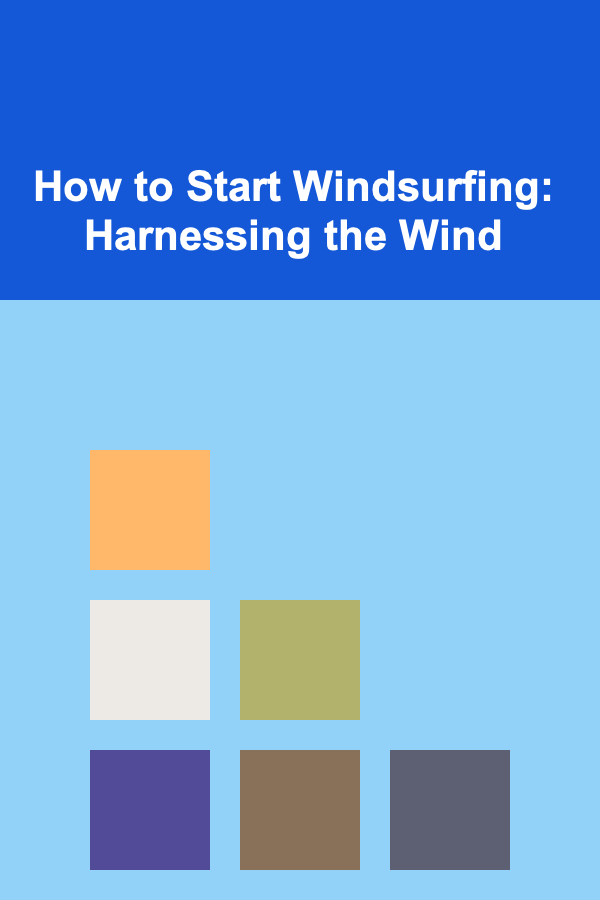
How to Start Windsurfing: Harnessing the Wind
ebook include PDF & Audio bundle (Micro Guide)
$12.99$8.99
Limited Time Offer! Order within the next:

Windsurfing is an exhilarating water sport that combines elements of surfing, sailing, and even skateboarding. It is a dynamic and challenging activity that allows individuals to glide over water while harnessing the wind's power. If you're looking to start windsurfing, you're about to embark on an exciting journey that requires patience, practice, and understanding of the elements. This guide will walk you through the essential steps, gear, and techniques to help you begin your windsurfing adventure and harness the wind like a pro.
The Basics of Windsurfing
Windsurfing involves riding a board with a sail that is mounted on a mast. The wind pushes the sail, and through a series of controlled maneuvers, the sailor steers the board across the water. Unlike traditional surfing, where the surfer rides waves, windsurfing is driven by the wind, making it an entirely different experience.
The key to mastering windsurfing is learning how to control the wind through the sail and using body positioning to guide the board. While this can sound challenging, once you understand the fundamentals, the feeling of freedom and excitement is unparalleled.
Key Components of Windsurfing
Before jumping into the technical aspects, it's important to understand the key components of the windsurfing setup:
- The Board: The board is your base, and it floats on the water. It comes in various sizes, from smaller boards for advanced riders to larger boards for beginners. Larger boards are more stable and easier to balance on.
- The Sail: The sail is what catches the wind and propels the board forward. Sails come in different sizes, and choosing the right size depends on wind conditions and your skill level.
- The Mast: The mast is a long pole that supports the sail and allows it to stand upright. It's generally made of lightweight materials like fiberglass or carbon fiber.
- The Boom: The boom is the horizontal bar attached to the sail that the windsurfer holds onto. It allows you to steer the sail and adjust its position to catch the wind efficiently.
- The Fin: Located at the rear of the board, the fin helps the board track straight in the water, providing stability and control.
- The Harness: A harness is a piece of gear that attaches to your body and the sail's boom, allowing you to transfer some of the wind's force to your body without over-exerting your arms.
Understanding each component and its role will help you appreciate how they work together to create a fluid and effective windsurfing experience.
Choosing the Right Location
The location is one of the most critical factors in starting windsurfing. Not all bodies of water are ideal for beginners, so it's important to choose a place that offers calm winds and flat water to make learning easier. Here are some factors to consider when choosing a location:
Wind Conditions
For beginners, light to moderate winds are ideal. Too strong of a wind can make controlling the sail difficult, while no wind at all will leave you stranded. Winds between 8 to 18 mph (13 to 29 km/h) are perfect for those starting out. Windsurfing schools typically offer lessons in areas where the wind conditions are manageable for novices.
Water Type
Flat water is the most suitable for beginners. Choppy or wavy water can make balancing on the board more challenging and increase the difficulty of learning to windsurf. Look for lakes, calm bays, or protected areas of the coastline.
Accessibility
When starting, it's important to choose a location with easy access to the water. Consider places where you can easily launch your board and return to shore when needed.
Safety
Ensure the area is safe for water sports, meaning there are no strong currents, rocks, or hazardous marine life. A lifeguard or rescue service nearby is also recommended for extra security.
Getting the Right Gear
The gear you choose plays a huge role in your windsurfing experience. While it's possible to rent gear when starting, understanding the different types of equipment can help you make an informed decision. Here's an overview of the essential windsurfing gear:
The Windsurfing Board
For beginners, a wider, larger board is more stable and easier to balance on. These boards, often called "beginner boards" or "float boards," have a larger surface area, which makes them more forgiving in the water. As you gain experience, you may transition to smaller boards for greater maneuverability.
The Sail
Sails are typically made from durable polyester or mylar and come in a variety of sizes. Beginners should start with a smaller sail (around 3.5 to 5.0 square meters) for easier control. The size of the sail should correspond to the wind conditions; lighter winds call for a larger sail, while stronger winds require a smaller one.
The Mast and Boom
The mast and boom need to be compatible with your sail and board. Most beginner setups will come with a mast that's designed for ease of use. The boom should be adjustable to allow you to find a comfortable grip.
Footstraps
Footstraps are used for advanced maneuvers and help windsurfers maintain control over the board. As a beginner, you may not need footstraps right away, but they are something to look forward to as you progress in your windsurfing journey.
Personal Safety Gear
Safety should always be your top priority. It's essential to wear a personal flotation device (PFD) or life jacket, especially when learning. A wetsuit is also advisable for insulation in colder waters, as it helps keep your body temperature stable.
Learning the Basics of Windsurfing
Once you have the right gear and the perfect location, the next step is learning how to windsurf. Windsurfing requires a combination of balance, coordination, and an understanding of how to control the sail. Here are some basic techniques to get you started:
Getting on the Board
- Start in Shallow Water: Stand in shallow water with the board perpendicular to the shore. Hold the mast with one hand and the boom with the other.
- Position the Sail: Position the sail so that it faces into the wind. This will help you understand how the wind interacts with the sail.
- Climb Onto the Board: Gently climb onto the board, keeping your weight balanced in the center. This step is crucial, as staying balanced is key to staying upright.
Catching the Wind
Once you're on the board, you'll want to catch the wind in your sail. Here's how to do it:
- Angle the Sail: Position the sail so it catches the wind at an angle. You should be slightly sideways to the wind, allowing the sail to push you forward.
- Pull on the Boom: Hold the boom with both hands and pull it towards you to catch more wind. This will move the board forward.
- Steer with Your Feet: Steer the board by adjusting the angle of your feet. Move your weight forward to speed up or backward to slow down.
Turning and Tacking
Turning is an essential skill that allows you to change direction while windsurfing. To do a basic tack, turn the sail in the direction you want to go while shifting your weight to the opposite side of the board. With practice, you'll learn how to carve through the water, using body movements to steer.
Windsurfing Terminology
As you start learning the basics, it's helpful to familiarize yourself with common windsurfing terminology:
- Upwind: Moving towards the wind.
- Downwind: Moving with the wind.
- Heeling: The technique of leaning to one side to change the board's angle.
- Footstrap: A strap you place your foot in for advanced maneuvers.
Overcoming the Challenges
Windsurfing can be challenging, especially for beginners. Here are some common hurdles and how to overcome them:
Balance Issues
If you're having trouble staying on the board, don't worry! Balance comes with practice. Focus on keeping your weight centered on the board and avoid leaning too far forward or backward. Keep your arms extended and your body upright to maintain stability.
Getting the Sail to Catch the Wind
At first, it may be difficult to get the sail to catch enough wind to propel you forward. If this happens, try adjusting the angle of the sail until you find the optimal position. If the wind is too light, you may need to use a larger sail.
Falling Off the Board
Falling is a natural part of the learning process. If you fall off the board, remain calm and swim back to it. With time, you'll be able to recover quickly after falling, gaining confidence in your abilities.
Progressing in Windsurfing
As you become more comfortable on the board, you can start learning more advanced techniques and maneuvers. These include:
- Jibe: A maneuver that allows you to change direction by turning the board downwind.
- Planing: Achieving speed and balance on the board, lifting out of the water for a smooth glide.
- Freestyle: Performing tricks and spins on the board, such as aerial jumps and slides.
Continuing Your Windsurfing Journey
The best way to improve is to keep practicing. Windsurfing is an evolving sport, and every session on the water will teach you something new. Whether you're trying a new maneuver, learning to read the wind, or adjusting your gear for optimal performance, there's always room for growth.
In addition to practicing, consider taking lessons from experienced instructors who can provide personalized guidance and tips to fast-track your progress. Joining a windsurfing community or club can also offer valuable support and opportunities to learn from others.
Starting windsurfing requires patience and practice, but the rewards are immense. From the thrill of harnessing the wind to the sense of freedom as you glide across the water, windsurfing offers an unmatched experience. By following this guide, you'll be well on your way to mastering the wind and enjoying one of the most exciting water sports around.

How to Create a Cozy and Organized Home Office Nook
Read More
How to Safely Introduce Your New Pet to Your Home
Read More
How to Set Up a Home Budget That Helps You Pay Off Debt
Read More
How to Use Bookends for Stylish Desk Organization
Read More
How to Understand the Privacy Implications of Surveillance Cameras
Read More
Designing Holiday-Themed Print-on-Demand Products
Read MoreOther Products

How to Create a Cozy and Organized Home Office Nook
Read More
How to Safely Introduce Your New Pet to Your Home
Read More
How to Set Up a Home Budget That Helps You Pay Off Debt
Read More
How to Use Bookends for Stylish Desk Organization
Read More
How to Understand the Privacy Implications of Surveillance Cameras
Read More